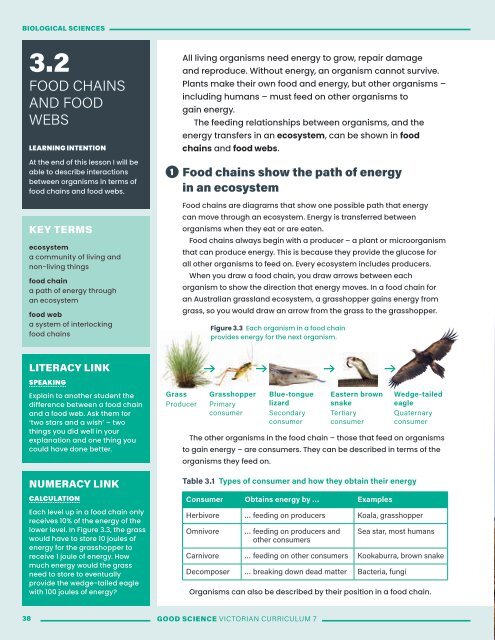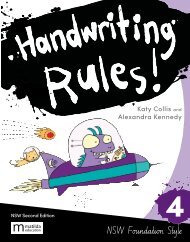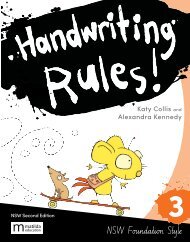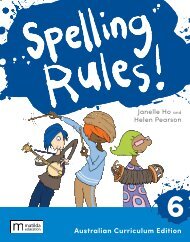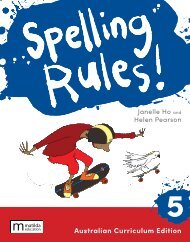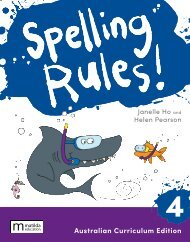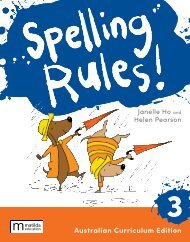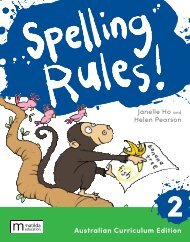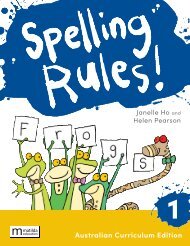Good Science Victorian Curriculum Year 7
Digital sample of Matilda's newest publication, Good Science Victorian Curriculum Year, authored by Emma Craven and Aaron Elias. For more information visit www.matildaeducation.com.au or email Katrina Tucker, katrinatucker@matildaed.com.au
Digital sample of Matilda's newest publication, Good Science Victorian Curriculum Year, authored by Emma Craven and Aaron Elias. For more information visit www.matildaeducation.com.au or email Katrina Tucker, katrinatucker@matildaed.com.au
Create successful ePaper yourself
Turn your PDF publications into a flip-book with our unique Google optimized e-Paper software.
BIOLOGICAL SCIENCES<br />
3.2<br />
FOOD CHAINS<br />
AND FOOD<br />
WEBS<br />
LEARNING INTENTION<br />
At the end of this lesson I will be<br />
able to describe interactions<br />
between organisms in terms of<br />
food chains and food webs.<br />
KEY TERMS<br />
ecosystem<br />
a community of living and<br />
non-living things<br />
food chain<br />
a path of energy through<br />
an ecosystem<br />
food web<br />
a system of interlocking<br />
food chains<br />
1<br />
All living organisms need energy to grow, repair damage<br />
and reproduce. Without energy, an organism cannot survive.<br />
Plants make their own food and energy, but other organisms –<br />
including humans – must feed on other organisms to<br />
gain energy.<br />
The feeding relationships between organisms, and the<br />
energy transfers in an ecosystem, can be shown in food<br />
chains and food webs.<br />
Food chains show the path of energy<br />
in an ecosystem<br />
Food chains are diagrams that show one possible path that energy<br />
can move through an ecosystem. Energy is transferred between<br />
organisms when they eat or are eaten.<br />
Food chains always begin with a producer – a plant or microorganism<br />
that can produce energy. This is because they provide the glucose for<br />
all other organisms to feed on. Every ecosystem includes producers.<br />
When you draw a food chain, you draw arrows between each<br />
organism to show the direction that energy moves. In a food chain for<br />
an Australian grassland ecosystem, a grasshopper gains energy from<br />
grass, so you would draw an arrow from the grass to the grasshopper.<br />
Figure 3.3 Each organism in a food chain<br />
provides energy for the next organism.<br />
LITERACY LINK<br />
SPEAKING<br />
Explain to another student the<br />
difference between a food chain<br />
and a food web. Ask them for<br />
‘two stars and a wish’ – two<br />
things you did well in your<br />
explanation and one thing you<br />
could have done better.<br />
NUMERACY LINK<br />
CALCULATION<br />
Each level up in a food chain only<br />
receives 10% of the energy of the<br />
lower level. In Figure 3.3, the grass<br />
would have to store 10 joules of<br />
energy for the grasshopper to<br />
receive 1 joule of energy. How<br />
much energy would the grass<br />
need to store to eventually<br />
provide the wedge-tailed eagle<br />
with 100 joules of energy?<br />
Grass<br />
Producer<br />
The other organisms in the food chain – those that feed on organisms<br />
to gain energy – are consumers. They can be described in terms of the<br />
organisms they feed on.<br />
Table 3.1 Types of consumer and how they obtain their energy<br />
Consumer Obtains energy by … Examples<br />
Herbivore … feeding on producers Koala, grasshopper<br />
Omnivore<br />
Grasshopper<br />
Primary<br />
consumer<br />
Blue-tongue<br />
lizard<br />
Secondary<br />
consumer<br />
… feeding on producers and<br />
other consumers<br />
Eastern brown<br />
snake<br />
Tertiary<br />
consumer<br />
Sea star, most humans<br />
Carnivore … feeding on other consumers Kookaburra, brown snake<br />
Decomposer … breaking down dead matter Bacteria, fungi<br />
Wedge-tailed<br />
eagle<br />
Quaternary<br />
consumer<br />
Organisms can also be described by their position in a food chain.<br />
38 GOOD SCIENCE VICTORIAN CURRICULUM 7


